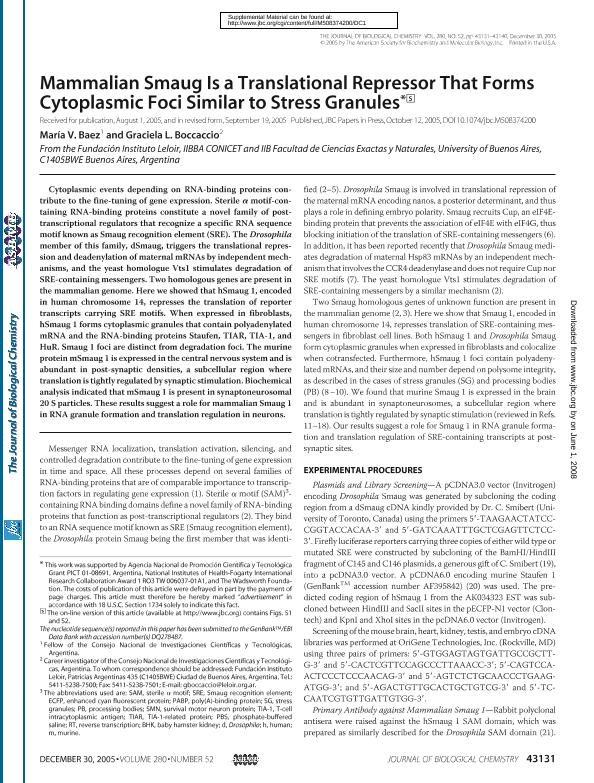Artículo
Mammalian smaug is a translational repressor that forms cytoplasmic foci similar to stress granules
Fecha de publicación:
12/2005
Editorial:
American Society for Biochemistry and Molecular Biology
Revista:
Journal of Biological Chemistry (online)
ISSN:
0021-9258
e-ISSN:
1083-351X
Idioma:
Inglés
Tipo de recurso:
Artículo publicado
Clasificación temática:
Resumen
Cytoplasmic events depending on RNA-binding proteins contribute to the fine-tuning of gene expression. Sterile α motif-containing RNA-binding proteins constitute a novel family of post-transcriptional regulators that recognize a specific RNA sequence motif known as Smaug recognition element (SRE). The Drosophila member of this family, dSmaug, triggers the translational repression and deadenylation of maternal mRNAs by independent mechanisms, and the yeast homologue Vts1 stimulates degradation of SRE-containing messengers. Two homologous genes are present in the mammalian genome. Here we showed that hSmaug 1, encoded in human chromosome 14, represses the translation of reporter transcripts carrying SRE motifs. When expressed in fibroblasts, hSmaug 1 forms cytoplasmic granules that contain polyadenylated mRNA and the RNA-binding proteins Staufen, TIAR, TIA-1, and HuR. Smaug 1 foci are distinct from degradation foci. The murine protein mSmaug 1 is expressed in the central nervous system and is abundant in post-synaptic densities, a subcellular region where translation is tightly regulated by synaptic stimulation. Biochemical analysis indicated that mSmaug 1 is present in synaptoneurosomal 20 S particles. These results suggest a role for mammalian Smaug 1 in RNA granule formation and translation regulation in neurons.
Palabras clave:
Stress Granules
,
Smaug
Archivos asociados
Licencia
Identificadores
Colecciones
Articulos(IIBBA)
Articulos de INST.DE INVEST.BIOQUIMICAS DE BS.AS(I)
Articulos de INST.DE INVEST.BIOQUIMICAS DE BS.AS(I)
Articulos(OCA HOUSSAY)
Articulos de OFICINA DE COORDINACION ADMINISTRATIVA HOUSSAY
Articulos de OFICINA DE COORDINACION ADMINISTRATIVA HOUSSAY
Citación
Baez, Maria Veronica; Boccaccio, Graciela Lidia; Mammalian smaug is a translational repressor that forms cytoplasmic foci similar to stress granules; American Society for Biochemistry and Molecular Biology; Journal of Biological Chemistry (online); 280; 52; 12-2005; 43131-43140
Compartir
Altmétricas




